

Linderhof Palace. Linderhof Palace Location of the palace.
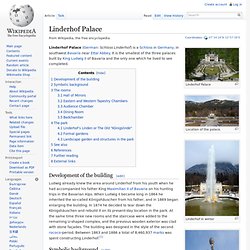
Linderhof in winter Facade. Ivory chandelier Venus Grotto The Moorish kiosk Moroccan House. Music Pavilion. Neuschwanstein Castle. Coordinates: Neuschwanstein Castle (German: Schloss Neuschwanstein, pronounced [nɔʏˈʃvaːnʃtaɪn], English: "New Swanstone Castle"[1]) is a nineteenth-century Romanesque Revival palace on a rugged hill above the village of Hohenschwangau near Füssen in southwest Bavaria, Germany.
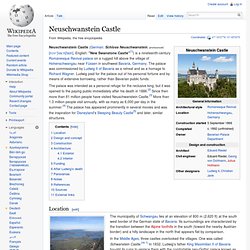
The palace was commissioned by Ludwig II of Bavaria as a retreat and as a homage to Richard Wagner. Ludwig paid for the palace out of his personal fortune and by means of extensive borrowing, rather than Bavarian public funds. Location[edit] Herrenchiemsee. Coordinates: New Palace of King Ludwig II After being purchased by King Ludwig II of Bavaria the former Herrenchiemsee monastery was converted into a royal residence known as the Old Palace (Altes Schloss), while the king built Herrenchiemsee Palace also known as the New Palace (Neues Schloss), the largest of his palaces.
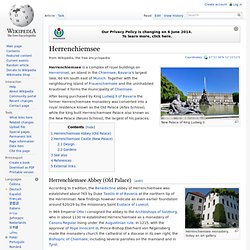
Herrenchiemsee Abbey (Old Palace)[edit] Herrenchiemsee monastery, today an art gallery. Amalienburg. Exterior The Amalienburg is an elaborate hunting lodge in the grounds of Nymphenburg Palace, Munich, southern Germany.
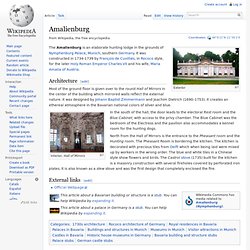
It was constructed in 1734-1739 by François de Cuvilliés, in Rococo style, for the later Holy Roman Emperor Charles VII and his wife, Maria Amalia of Austria. Architecture[edit] Nymphenburg Palace. The Nymphenburg Palace (German: Schloss Nymphenburg), i.e.

"Nymph's Castle", is a Baroque palace in Munich, Bavaria, southern Germany. The palace was the main summer residence of the rulers of Bavaria of the House of Wittelsbach. History[edit] Nymphenburg Palace, around 1760, as painted by Canaletto. Schleissheim Palace. Würzburg Residence. The Würzburg Residence (German: Würzburger Residenz) is a palace in Würzburg, southern Germany.
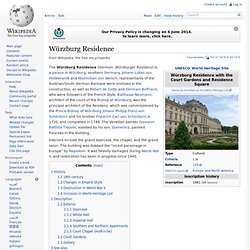
Johann Lukas von Hildebrandt and Maximilian von Welsch, representants of the Austrian/South German Baroque were involved in the construction, as well as Robert de Cotte and Germain Boffrand, who were followers of the French Style. Castle Solitude. Castle Solitude in Stuttgart, Germany (German: Schloss Solitude), was built as a hunting lodge between 1764 and 1769 under Duke Karl Eugen of Württemberg.
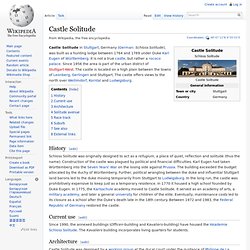
It is not a true castle, but rather a rococo palace. Since 1956 the area is part of the urban district of Stuttgart-West. The castle is located on a high plain between the towns of Leonberg, Gerlingen and Stuttgart. The castle offers views to the north over Weilimdorf, Korntal and Ludwigsburg. History[edit] Schloss Favorite, Ludwigsburg. Schloss Favorite Schloss Favorite is a Baroque maison de plaisance and hunting lodge in Ludwigsburg, Germany.

It is located on a rise, directly north of Ludwigsburg Palace. It was built from 1717 to 1723 for the sovereign Duke of Württemberg, Eberhard Ludwig, to a design by Donato Giuseppe Frisoni. From 1806, King Frederick I of Württemberg converted the park into a ménagerie, including deer and chamois. The architect Nikolaus Friedrich von Thouret renovated the building's interior in neoclassical style. In the 20th century, the house was neglected and fell into disrepair. See also[edit] Schloss Favorite (Rastatt) Schloss Favorite front view Schloss Favorite is a castle on the outskirts of Rastatt-Förch in Baden-Württemberg, Germany.

Built by Johann Michael Ludwig Rohrer between 1710 and 1730, it was a pleasure and hunting palace (French: Maison de plaisance) used by Margravine Franziska Sibylla Augusta of Sachsen-Lauenburg, widow of Louis William, Margrave of Baden-Baden ('Türkenlouis'). It is the oldest of the German so-called 'Porcelain Palaces' and the only to survive intact to this day.
The castle was only used for several weeks a year as a summer residence. The castle houses a large collection of Chinese porcelain, black lacquerwork and Schwartz Porcelain. New Palace (Stuttgart) The New Palace viewed from the opposite side of Schlossplatz The New Palace (German: "das Neue Schloss", which may also be translated as New Castle) is a building which stands on the south edge of Schlossplatz, the central square in Stuttgart, Germany.
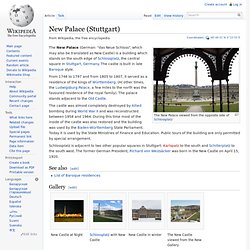
The castle is built in late Baroque style. The castle was almost completely destroyed by Allied bombing during World War II and was reconstructed between 1958 and 1964. Karlsruhe Palace. Aerial overview Karlsruhe Palace (German: Karlsruher Schloss) was erected in 1715 by Margrave Charles III William of Baden-Durlach, after a dispute with the citizens of his previous capital, Durlach. The city of Karlsruhe has since grown around it. History[edit] Originally partially made of wood, the palace had to be rebuilt in 1746, using stone. Charles Frederick, Margrave of Baden-Durlach at the time, and who eventually became Charles Frederick, Grand Duke of Baden then had the palace altered by Balthasar Neumann and Friedrich von Kesslau until 1770, adding larger windows and doors, pavilions and wings.
Ludwigsburg Palace. Ludwigsburg Palace and Baroque Gardens (near Stuttgart, Germany) from the south. Courtyard of Ludwigsburg Palace, looking north Ludwigsburg Palace (German: Schloss Ludwigsburg) is a historical building in the city of Ludwigsburg (12 km north of Stuttgart's city centre), Germany. It is one of the country's largest Baroque palaces and features an enormous garden in that style. From the 18th century to 1918 it was the principal royal palace of the dukedom that became in 1806 the Kingdom of Württemberg. History[edit] The foundation stone was laid on May 17, 1704 under Duke Eberhard Ludwig of Württemberg (reigning monarch from 1693 to 1733). Schloss Rastatt. Castle Rastatt Schloss Rastatt is a baroque schloss in Rastatt, Germany. The palace and the Garden were built between 1700 and 1707 by the Italian architect Domenico Egidio Rossi as ordered by Margrave Louis William of Baden.
History[edit] Schloss Benrath. Schloss Benrath (Benrath Palace) is a Baroque maison de plaisance (fr. for pleasure palace) in Benrath, which is now a suburb of Düsseldorf. It was erected for the Elector Palatine Charl Theodor and his wife Countess Palatine Elisabeth Auguste of Sulzbach by his garden and building director Nicolas de Pigage. Construction began in 1755 and was completed in 1770. The ensemble at Benrath has been proposed for designation as a UNESCO World Heritage Site. Buildings[edit] Augustusburg and Falkenlust Palaces, Brühl. The Augustusburg and Falkenlust palaces is a historical building complex in Brühl, North Rhine-Westphalia, Germany, which have been listed as a UNESCO cultural World Heritage Site since 1984. They are connected by the spacious gardens and trees of the Schlosspark. Schloss Weißenstein. Main Wing Courtyard From South Schloss Weißenstein is a palatial residence in Pommersfelden, Bavaria, southern Germany. It was designed for Lothar Franz von Schönborn, Prince-Bishop of Bamberg and Archbishop of Mainz, to designs by Johann Dientzenhofer and Johann Lukas von Hildebrandt.
The Marstall (luxury stable) had been designed by Maximilian von Welsch. The castle was built between 1711 and 1718 from local sandstone materials.[1] The edifice is located in a rural area in southern Germany, which does not have industrial air pollution. Schloss Nordkirchen.